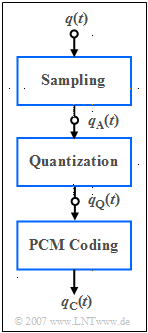Difference between revisions of "Aufgaben:Exercise 1.2Z: Puls Code Modulation"
From LNTwww
| Line 62: | Line 62: | ||
===Solutions=== | ===Solutions=== | ||
{{ML-Kopf}} | {{ML-Kopf}} | ||
| − | '''(1)''' | + | '''(1)''' Correct are the <u>solutions 1, 2 and 4</u>: |
| − | * | + | *The source signal ${q(t)}$ is analog, i.e. '' time- and value-continuous''. |
*Im Allgemeinen macht es keinen Sinn, ein deterministisches Signal zu übertragen. | *Im Allgemeinen macht es keinen Sinn, ein deterministisches Signal zu übertragen. | ||
*Für die mathematische Beschreibung eignet sich ein deterministisches Quellensignal – wie zum Beispiel ein periodisches Signal – besser als ein Zufallssignal. | *Für die mathematische Beschreibung eignet sich ein deterministisches Quellensignal – wie zum Beispiel ein periodisches Signal – besser als ein Zufallssignal. | ||
| Line 70: | Line 70: | ||
| − | '''(2)''' | + | '''(2)''' Correct are the <u>solution suggestions 2 and 3</u>: |
*Das Signal $q_{\rm A}(t)$ nach der Abtastung ist weiterhin ''wertkontinuierlich'', aber nun ''zeitdiskret''. | *Das Signal $q_{\rm A}(t)$ nach der Abtastung ist weiterhin ''wertkontinuierlich'', aber nun ''zeitdiskret''. | ||
*Die Abtastfrequenz $f_{\rm A}$ ist dabei durch das so genannte ''Abtasttheorem'' vorgegeben. | *Die Abtastfrequenz $f_{\rm A}$ ist dabei durch das so genannte ''Abtasttheorem'' vorgegeben. | ||
| Line 77: | Line 77: | ||
| − | '''(3)''' | + | '''(3)''' Correct are the <u>solution suggestions 1 and 3</u>: |
*Das quantisierte Signal $q_{\rm Q}(t)$ ist zeit- und wertdiskret, wobei die Stufenzahl $M = 2^8 = 256$ beträgt. | *Das quantisierte Signal $q_{\rm Q}(t)$ ist zeit- und wertdiskret, wobei die Stufenzahl $M = 2^8 = 256$ beträgt. | ||
| − | * | + | *A binary signal, on the other hand, is a discrete value signal with the number of steps $M = 2$. |
Revision as of 20:34, 13 August 2020
All modern communication systems are digital. The principle of digital transmission of speech signals goes back to Alec Reeves , who invented the so-called Pulscodemodulation (PCM) already at 1938.
On the right you see the (simplified) block diagram of the PCM transmitter with three functional units:
- The band-limited speech signal ${q(t)}$ is sampled, where the Abtasttheorem is observed, and yields the sampled signal $q_{\rm A}(t)$.
- Each sample $q_{\rm A}(t)$ is mapped to one of $M = 2^N$ and results in the quantized signal $q_{\rm Q}(t)$.
- Each individual quantized value is represented by a code sequence of $N$ binary symbols and results in the coded signal $q_{\rm C}(t)$.
In this task only the different signals of the PCM transmitter are to be classified. Later tasks will deal with other properties of pulse code modulation.
Notes: This task belongs to the chapter Klassifizierung von Signalen.
Questions
Solutions
(1) Correct are the solutions 1, 2 and 4:
- The source signal ${q(t)}$ is analog, i.e. time- and value-continuous.
- Im Allgemeinen macht es keinen Sinn, ein deterministisches Signal zu übertragen.
- Für die mathematische Beschreibung eignet sich ein deterministisches Quellensignal – wie zum Beispiel ein periodisches Signal – besser als ein Zufallssignal.
- Deterministische Signale werden auch für den Testbetrieb herangezogen, um erkannte Fehlfunktionen rekonstruieren zu können.
(2) Correct are the solution suggestions 2 and 3:
- Das Signal $q_{\rm A}(t)$ nach der Abtastung ist weiterhin wertkontinuierlich, aber nun zeitdiskret.
- Die Abtastfrequenz $f_{\rm A}$ ist dabei durch das so genannte Abtasttheorem vorgegeben.
- Je größer die maximale Frequenz $f_{\rm N,\,max}$ des Nachrichtensignals ist, desto größer muss $f_{\rm A} ≥ 2 \cdot f_{\rm N,\,max}$ gewählt werden.
(3) Correct are the solution suggestions 1 and 3:
- Das quantisierte Signal $q_{\rm Q}(t)$ ist zeit- und wertdiskret, wobei die Stufenzahl $M = 2^8 = 256$ beträgt.
- A binary signal, on the other hand, is a discrete value signal with the number of steps $M = 2$.
(4) Richtig sind hier die Lösungsvorschläge 1, 3 und 5:
- Das codierte Signal $q_{\rm C}(t)$ ist binär $($Stufenzahl $M = 2)$ mit Bitdauer $T_{\rm B} = T_{\rm A}/8$.
